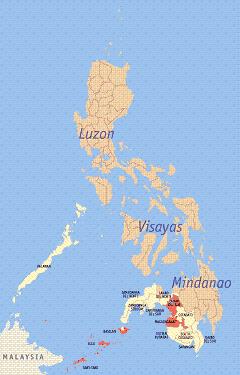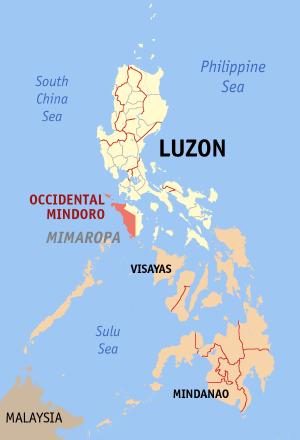 The first inhabitants of the Philippines were Negritos who came 30,000 years ago from Borneo, Sumatra, and Malaya. Theirs was a primitive barangay (village type) governing system revolving round the tribal chief or the Datu –a title for a tribal headman which survived among the natives till recent times.Thereafter the Malayans continued to flow into the islands in successive waves; the last wave being Muslim Malays after all of Malaya had converted to Islam.
The first inhabitants of the Philippines were Negritos who came 30,000 years ago from Borneo, Sumatra, and Malaya. Theirs was a primitive barangay (village type) governing system revolving round the tribal chief or the Datu –a title for a tribal headman which survived among the natives till recent times.Thereafter the Malayans continued to flow into the islands in successive waves; the last wave being Muslim Malays after all of Malaya had converted to Islam.
The credit for the conversion of both Malaya and Indonesia to Islam goes to the Rowther and Marakkar. They were a gentle peace loving people who went in wooden boats from Kerala and Tamil Nadu in India to trade with far off lands. The word Marakkar is derived from the Tamil term Marakalam – a boat made of wood. These people played such a pivotal role in developing the Malay States that to this day several streets and places there are named after Marakkars.Their most outstanding contribution was bringing peace, commerce, and a higher form of government to replace the mutually warring village based tribal systems spread through out most of the area.
To speed up conversion these traders inter-married with the rich and powerful; often finding themselves in the direct line of succession to the local ruler- sometimes even succedding him on his death.There is some evidence that Islam first spread in the Philipines through a similar process.For we find mention of Philipine Rajas with Indian sounding names even before the dates Islam is officialy accepted as having arrived in The Philipines.
The Sultanat of Sulu officialy thought to have been founded in 1450,is claimed by some Muslim historians to have been founded centuries earlier in the time of Raja Baguinda Ali.We are also informed that Shariff Mohammed Kabungsuwan of Johor introduced Islam in the area at the end of the 12th century. He subsequently married a local princess and establishing the Sultanate of Maguindanao, possibly in 1203 or 1205.
What ever be the case,the migration of Malay-Arabs into the Philipines certainly increased dramatically after the conquest of Malaya by the Portuguese .The flood of escaping refugees – including several Malaysian princes ,displaced court advisors and many Muslim missionaries, including Makhdum Karim(1380) – is credited with the large scale conversion of the native population to Islam. So while the earlier trade(1200) with Malays may have helped to establish the initial foothold of Islam in Philipines ,the establishment of bigger Muslim sultanats may have come much later.
In any case big Muslim sultanates got established alongside the existing indigenous Filipino barangay (village) governing systems and Indianized royalty. The two largest were the Sultanate of Maguindanao, which governed most of southern Mindanao and the Sultanate of Sulu, which at its peak, stretched over the islands bordering the western peninsula of Mindanao in the east, the modern Malaysian state of Sabah in the west and south, and Palawan in the north. Several other smaller but famous sultanates were also established such as the sultanat of Buayan, sultanate of Lanao in Mindanao and the sultanate of Cebu.
Apart from the sultanats mentioned above ,many of the inhabitants of the pre-Hispanic Philippines were Muslims. Rajah Sulayman, is one example. He was a native Muslim king of the 16th century who, together with Rajah Matanda and Rajah Lakandula, the king of the Tondo area, ruled a large population of Kapampangans/Tagalogs in the southern part of the Pasig River and the city of Manila .
This way in over 350 years since it’s first arrival in the Philipines Islam had slowly but peacefully spread over one fourth of the Philipines landmass. As we shall see next, the arrival of the Spanish was to shatter this garden of peace , tranquality and bliss which Malay Muslims of The Philipines were in the proces of creating.
Yet the next 500 years of Philipine history is an undeniably amazing proof of the great values and strength they gave to the natives whose hearts they had won.In the Philipines today, in the face of continous terrorism let lose by it’s successive occupiers; of all native populations only the one’s amongst whom Muslim values held sway proved strong enough to continue retaining their original values .
Philipines Under Spanish Rule.The first European to visit the islands was a Portuguese explorer Ferdinand Magellan (1521). Other Spanish expeditions followed, including the one in 1542 when Lopez de Villalobos named the islands for the infante Philip, later Philip II. How ever the Spanish conquest of the Filipinos did not begin in earnest until 1564, when people like Miguel Lopez de Legaspi, Martin de Goiti and Juan de Salcedoarrived with troops.
Used to Muslim traders the natives initially welcomed and befriended the Spanish , offering them spices as gifts and hospitality during their stay. But as the weeks passed and the Spaniards would not depart- and also began to abuse them – the people soon realized that the Spanish were there not to trade but to rule over their souls and bodies.The many small helpless village type native non-Muslim communities spread in 2/3 of The Philippines, having no central rule and unity – were powerless to resist and were soon over awed and converted. The Spanish faced no difficulty in integrating the northern and middle regions of the current Philippines into their growing catholic empire. However, the Muslim South was a different matter ; It resisted and remained a comparitively free area for a long time.
The little initial resistance on the mainland was also only from the Muslims (The Moros).This too is a word derived from Moors, the famous derogatory term for Muslims coined in Spain. Raja Sulayman (in Manila) realizing the true intent of the Spaniards led a coup to throw the Spaniards out of the city. On the morning of May 24, 1570, The Battle of Bangkusay, a district of present day Tondo, took place between thousands of Macabebe warriors against 300 Spanish soldiers. Defenseless against Spanish steel, and the fury of newly Christianized tribes, Sulayman, Lakandula and Matanda’s armies were defeated and the city burned to the ground.
The three kings were captured and held as a prisoners by Martín de Goiti. Despite this the surviving troops retreated to the jungles of Manila , reemerging to lay laid siege to the Spanish settlement for several months. On June 24, 1571 the Spanish General, Miguel López de Legazpi arrived with fresh troops to break the siege . The besigers were captured ,and along with the Rajahs Lakandula and Matanda converted to Roman Catholicism . It was only after this establishment of the Spanish city of Manila on the site of this Moro town that the Spanish felt their hold on the Philippines was secure.
Even though most of the Philippines mainland ended up under the Spanish rule ,the Spanish in fact had little actual control over the area of The Moros as they called the Muslims. The Muslim areas on the mainland along with the Muslim inhabitants of the Sulus and Mindanao fiercely resisted Spanish attempts at forcible conversion to Catholicism. In the face of this stiff resistance, the Spanish were restricted to a handful of coastal garrisons, and could make only occasional punitive expeditions into the interior of Muslim (moro) land. They therefore contented themselves with only erecting and manning these garrisons ,the most notable of which were Zamboanga and Cotabato.
Feeling threathened by these actions, Moros decided to challenge Spanish authority. They started raids on Spanish coastal towns- and kept these going for hundreds of years .After centuries of fighting Spanish forces finally captured the city of Jolo, the seat of the Sultan of Sulu, in 1876.But they were so exhausted and alarmed at the prospects of the struggle continuing that The Spanish and the Sultan of Sulu signed the Spanish Treaty of Peace on July 22, 1878. Control of the Sulus outside the Spanish garrisons was left in the hands of the Sultan.The Moros had managed to retain their independence-barely!
But in all this,forces beyond the comprehension of the Moros had been in play –and had now come to their rescue, as they will no doubt continue to do in the future. As the holy Quran states: “man scheames;And God has his own scheam –and God’s is the best of schemes.”
After centuries as Spanish colonies, its simple catholic convertee’s every where were waking up to reality. Their souls had been bought in the name of religion and promise of post life bliss; but their existing lives and bodies had been confined to a hell on earth, dedicated solely to the purpose of satisfying Spain’s inexhaustible needs. Natives (even catholic ones) were second-class citizens in their own country. Career options were limited, and the colonial masters practiced rampant racism. Even though the people had become devoutly Catholic, the priesthood was denied them. More over Spanish priests far from practicing holiness, often served as auxiliaries in the Spanish military, ruled their parishes like feudal fiefdoms and their parishioners like serfs.
Three and a half centuries of fighting to acquire colonies, convert its inhabitants and then keep on quelling the thousands of local insurrections which kept on erupting year after year in its many colonies had left Spain weak and bankrupt. About this time the USA having got over its Red Indian and civil wars was flexing its wings –ready to join the Europeans as a world power. It was this combination of events which had come to the help of the Moros in getting a favourable treaty with The Spanish.
Meanwhile The Philipines, Cuba, Puerto Rico, Guam…all of its other catholic colonies were awaiting a deliverer; The Philipines found not one-but two.
In 1896 a revolution led in part by Emilio Aguinaldo broke out in the Philippine Islands. And in 1898 Admiral Dewey showed up with the US fleet in Manila bay!!But that is a story of butchery and terrorism I shall reserve for another day.



